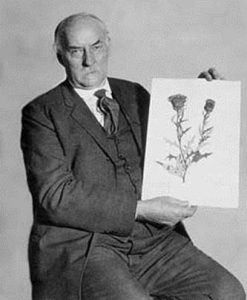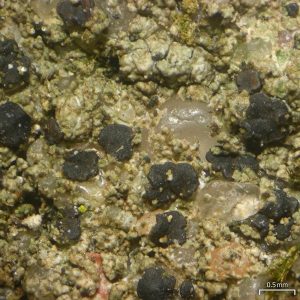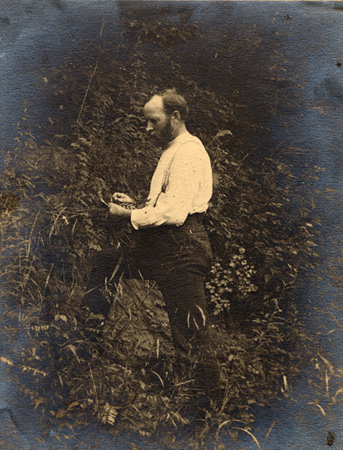(1862 – 1931)
The University of North Carolina at Chapel Hill Herbarium (NCU) curates about 130 fungal specimens collected by Louis Pammel. All NCU’s fungal specimens, including those collected by Pammel, can be found at mycoportal.org . The photograph of Pammel collecting plants is courtesy of the Iowa State University Library Special Collections & University Archives. (1)
+++++
THE FOLLOWING BIOGRAPHY IS FROM: Iowa State University, Sesquicentennial Celebration, History of Iowa State: People of Distinction, “Louis H. Pammel”
Louis H. Pammel was born in LaCrosse, Wisconsin in 1862. He graduated from the University of Wisconsin, being the first student to receive a Bachelor of Agriculture degree (1885) from that institution. He graduated with honors for his research of parasitic fungi, including downey mildew of millet. Pammel also received his M.S. (1889) in agriculture from the University of Wisconsin and his Ph.D. (1898) from Washington University. He obtained training under such distinguished professors as Dr. William Trelease, Professor in the Shaw School of Botany at Washington University; Dr. E. A. Birge, Professor of Zoology and a President of the University of Wisconsin; Dr. C. R. Van Hise, Professor of Chemistry and Minerology, also a University of Wisconsin President (1903-1918).
After graduating from the University of Wisconsin, L. H. Pammel became an assistant (1885) to Dr. W. G. Farlow of Harvard University, who was in charge of cryptogamic botany. Later, he became an assistant (1885-1887) in botany at the Shaw School of Botany, Washington University. For two summers he investigated the cotton root rot in Texas (1888 and 1889).
In February 1889, Pammel came to Iowa State College (University) as Professor of Botany (1889-1929) a position made vacant by the resignation of Dr. Byron Halsted (1884-1888). In addition to teaching botany, he taught courses in Landscape Architecture (1889-1890). Pammel was also the Iowa State College Experiment Station Botanist (1889-1922). During Pammel’s tenure, Iowa State became the first school in the United States to offer bacteriology courses to general students.

Pammel was also a well liked [sic] and respected by his students, many of which considered him a great influence in their lives. Among these students was George Washington Carver. In 1891, Carver became the first African-American to enroll at Iowa State College of Agriculture and Mechanic Arts (Iowa State University). Pammel encouraged him to stay at Iowa State as a graduate student after he completed his bachelor’s degree (1894). Over the next two years, as assistant botanist for the College Experiment Station, Carver quickly developed scientific skills and plant pathology and mycology, the branch of botany that deals with fungi. He published several articles on his work and gained national respect. Carver completed his master’s degree (1896) and was invited by Booker T. Washington to join the faculty of Alabama’s Tuskegee Institute. Pammel and Carver remain in close contact after Carver moved to Alabama.
Pammel conducted research in plant pathology and in weeds, which resulted in numerous publications, including A Manual of Poisonous Plants (1910), Weeds of the Farm and Garden (1911), and The Weed Flora of Iowa (1913, 1926). Other research activities included the anatomy of seeds and plants of the legume family. In systematic botany, he was interested in the trees and other floor of the country, and he made extensive collections of plants, which he gave to the college. For the United States Forest Service, he made a study of grazing conditions in the Uintah Mountains, and did work on grasses of the Plains region for the U.S. Department Of Agriculture. Many honors were conferred upon Dr. Pammel…
Pammel married Augusta Emmel of Chicago, Illinois in 1887 and they had six children, five daughters and one son. He died in 1931 on a transcontinental train traveling through Nevada.
+++++
More than a dozen organisms have been named in Louis Pammel’s honor including:
Aecidium pammelii Trel.
Cephalosporium pammelii R. E. Buchanan
Entyloma pammelii H. H. Hume
Phyllachora pammelii Orton
Puccinia pammelii Arthur
Bilimbia pammellii Fink
Melica subulata var. pammelii (Scribn.) C. L. Hitchc.

Dr. Pammel was the Curator of the Herbarium at Iowa State College (ISC) from 1889 to 1931, and added ca. 50,000 plants to the collection. Pammel also arranged the herbarium’s purchase for $5,000 of the C. C. Parry Collection which contained many type specimens of plants of Iowa, the American West, and Mexico.5
“Dr. Pammel’s last major activity, and the one by which he was best known to the public, was in the field of conservation. He wrote the Iowa conservation bill and served as the first chairman of the Iowa Conservation Board. During his regime 36 state parks were required, and the lakes of the state were placed under the control of the Conservation Board, making a total area of 10,000 acres dedicated to state park purposes.”3 Pammel State Park in Madison County, Iowa, dedicated in 1928, was one of Iowa’s first state parks. It features a limestone ridge known as the “Backbone” which is home to some of the oldest oak trees in the State.4
PUBLICATIONS by Pammel:.
Pammel, L. H. 1886. On the structure of the testa of several Leguminous seeds. Bull. Torr. Bot. Club 13(2) 17-24.
—–. 1888. Some mildews of Illinois. J. Mycology 4(4/5): 36-38.
—–. 1888. Color variation in flowers of Delphinium. Botanical Gazette 13(8): 216.
—–. 1889. Cotton Root-rot. Texas Agricultural Experiment Station Bulletin No. 7. State Printing Office, Austin, Texas.
—–. 1891. Fungus diseases of Iowa forage plants. Contr. To Monthly Review of Iowa Weather and Crop Service 2: 9.
—–. 1892. Phaenological notes. Bull. Torr. Bot. Club 19(12): 375-382.
—–. 1892. New fungous diseases of Iowa. J. Mycology 7(2): 95-103.
—–. 1892. Wind-storms and trees. Science 19(479): 205.
—–. 1893. Botanical papers presented at the New Orleans meeting of the American Association of Agricultural Colleges and Experiment Stations. Bot. Gazette 18(1): 25-28.
—–. 1893. Notes on the pollination of plums. Science 21(541): 331.
—–. 1893. Crossing of Cucurbits. Bull. Torrey Bot. Club 20(9): 358-359.
—–. 1893. Some recent books on bacteriology. The American Naturalist 27(318): 554-556.
—–. 1893. Notes on Cicuta maculata. Bull. Torrey Bot. Club 20(11): 441-442.
—–. 1894. Mr. MacDougal and poisoning from Cypripedium spectabile. Science 23(581): 162.
—–. 1898. Old lake vegetation in Hamilton County, Iowa. The Plant World 2(3): 42-45.
—–. 1898. Comb’s flora of Santa Clara Province, Cuba. The American Naturalist 32(377): 369-370.
—–. 1898. Brown Rot of Cruciferous plants. The American Naturalist 32(376): 290-291.
—–. 1898. Morphology and development of Astasia asterospora and Bacillus tumescens. The American Naturalist 32(376): 287-290.
—–. 1899. Some ecological notes on the Muscatine flora. The Plant World 2(11): 182-186.
Pammel, Louis Hermann. 1899. Anatomical characters of the seeds of Leguminosae, chiefly genera of Gray’s Manual. Presented to The Academy of Science of St. Louis March 20, 1899, a thesis for the degree of Doctor of Philosophy, submitted to the Faculty of Washington University, March, 1899. Transactions of The Academy of Science of St. Louis 4(6).
Pammel, L. H., J. B. Weems, and F. Lamson-Scribner. 1901. The Grasses of Iowa. Bulletin No. I, of the Iowa Geological Survey. F. R. Conway, State Printer, Iowa.
Pammel, L. H. 1901. Iowa Academy of Sciences. Science, New Series 13(319): 214-216.
—–. 1901. Rare plants and their disappearance. The Plant World 4(8): 151-152.
—–. 1902. Our vanishing wildflowers. The Plant World 5(9): 173-175.
—–. 1902. Review of “Garden beans cultivated as esculents” by H. C. Irish. The American Naturalist 36(427): 593-594.
—–. 1902. An old Sphagnum bog in La Cross County, Wisconsin. The Plant World 5(11): 226-228.
—–. 1905. Notes on some plants of northeastern Iowa. The Plant World 8(2): 31-35.
—–. 1906. Central building of Iowa State College of Agriculture and Mechanic Arts. Science, New Series 24(613): 413.
—–. 1906. Northern limit of the papaw tree. Science, New Series 24(602): 48.
—–. 1910. [incomplete citation; title needed] Breeder’s Gazette
Pammel, L. H., Charlotte M. King, A. L. Bakke. 1910. Two barley blights, with comparison of species of Helminthosporum upon cereals. Experiment Station Bulletin 116, Iowa State College of Agriculture and Mechanic Arts, Botany Section. Pp. 179-188. Ames, Iowa.
Pammel, L. H.. 1910. Rocky Mountain rambles. The Plant World 13(7): 155-163.
—–. 1910. Rocky Mountain rambles (continued). The Plant World 13(8): 181-190.
—–. 1911. A Manual of Poisonous Plants, chiefly of Eastern North America, with brief notes on Economic and Medicinal Plants. The Torch Press, Cedar Rapids, Iowa.
—–. 1911. Weeds of the Farm and Garden. Orange Judd Company, New York.
—–. 1913. The Weed Flora of Iowa. Bulletin No. 4, Iowa Geological Survey, Des Moines, Iowa.
—–. 1915. Review of “A Manual of Weeds, with descriptions of all the most troublesome plants in the United States and Canada, their habits of growth and distribution, with methods of control” by Ada E. Georgia. The Plant World 18(2): 48-49.
—–. 1918. Prickly lettuce. Rhodora 20(238): 180-181.
—–. 1918. Review of “The Botany of Crop Plants” by Wilfred W. Robbins. Science, New Series 47(1208): 194-195.
—–. 1920. State Parks in Iowa. The Scientific Monthly 10(5): 516-521.
Stevens, F. L., L. H. Pammel, Mel T. Cook. 1920. Byron David Halsted. Am. J. Botany 7(8): 305-317.
Pammel, L. H. 1921. Some economic phases of Botany. Science, New Series 53(1358): 4-15.
—–. 1925. The extension of the Yucca Moth. Science, New Series 61(1581): 414-415.
—–. 1928. The pollination of scarlet sage flowers by hummingbirds. The Wilson Bulletin 40(4): 248-249.
—–. 1929. Benjamin Dann Walsh. J. Illinois State Historical Soc. 21(4): 556-568.
—–. 1929. Review of “The Soils of Cuba” by Hugh H. Bennett and Robert V. Allison. Ecology 10(2): 251-256.
Pammel, Louis H. and Charlotte M. King (1930?) Honey Plants of Iowa. Iowa Geological Survey [incomplete citation]
Sources:
- http://www.public.iastate.edu/~isu150/history/pammel.htmlaccessed on 19 July 2017.
2. http://www.waysofenlichenment.net/lichens/Bacidia%20coprodes accessed on 19 July 2017.
3. Erwin, A. T. 1931. Louis Hermann Pammel. Science, New Series 73(1901): 604-605.
4. http://www.madisoncountyconservation.org/pammel-park/ accessed on 19 July 2017.
5. http://www.herbarium.iastate.edu/historypage.html accessed on 20 July 2017.
